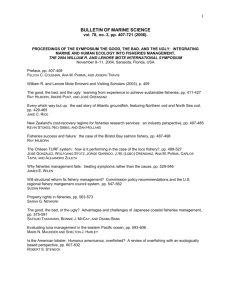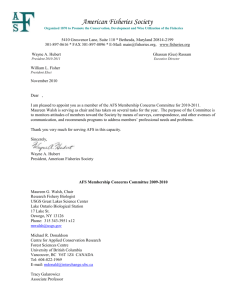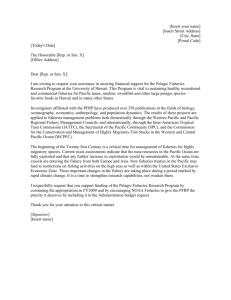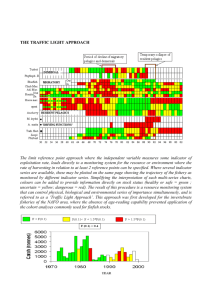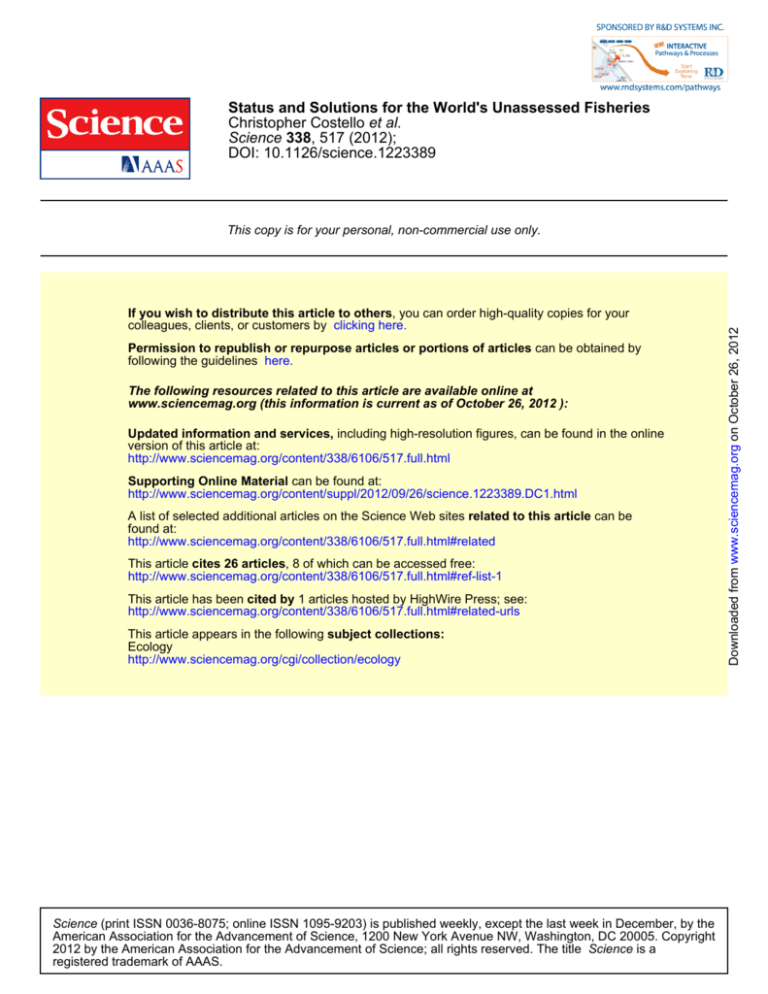
Status and Solutions for the World's Unassessed Fisheries
Christopher Costello et al.
Science 338, 517 (2012);
DOI: 10.1126/science.1223389
If you wish to distribute this article to others, you can order high-quality copies for your
colleagues, clients, or customers by clicking here.
Permission to republish or repurpose articles or portions of articles can be obtained by
following the guidelines here.
The following resources related to this article are available online at
www.sciencemag.org (this information is current as of October 26, 2012 ):
Updated information and services, including high-resolution figures, can be found in the online
version of this article at:
http://www.sciencemag.org/content/338/6106/517.full.html
Supporting Online Material can be found at:
http://www.sciencemag.org/content/suppl/2012/09/26/science.1223389.DC1.html
A list of selected additional articles on the Science Web sites related to this article can be
found at:
http://www.sciencemag.org/content/338/6106/517.full.html#related
This article cites 26 articles, 8 of which can be accessed free:
http://www.sciencemag.org/content/338/6106/517.full.html#ref-list-1
This article has been cited by 1 articles hosted by HighWire Press; see:
http://www.sciencemag.org/content/338/6106/517.full.html#related-urls
This article appears in the following subject collections:
Ecology
http://www.sciencemag.org/cgi/collection/ecology
Science (print ISSN 0036-8075; online ISSN 1095-9203) is published weekly, except the last week in December, by the
American Association for the Advancement of Science, 1200 New York Avenue NW, Washington, DC 20005. Copyright
2012 by the American Association for the Advancement of Science; all rights reserved. The title Science is a
registered trademark of AAAS.
Downloaded from www.sciencemag.org on October 26, 2012
This copy is for your personal, non-commercial use only.
REPORTS
References and Notes
1. E. H. Ashton, C. E. Oxnard, Proc. Zool. Soc. Lond. 142,
49 (1964).
2. V. Inman, J. Saunders, L. Abbott, J. Bone Joint Surg. Am.
26, 1 (1944).
3. C. E. Oxnard, Am. J. Phys. Anthropol. 26, 219 (1967).
4. D. Roberts, Structure and function of the primate
scapula, in Primate Locomotion, F. A. Jenkins, Ed.
(Academic Press, New York, 1974), pp. 171–200.
5. A. Schultz, Hum. Biol. 2, 303 (1930).
6. N. M. Young, thesis, Harvard University (2002).
7. N. M. Young, Am. J. Phys. Anthropol. 136, 247 (2008).
8. Z. Alemseged et al., Nature 443, 296 (2006).
9. C. V. Ward, Yearb. Phys. Anthropol. S 35, 185 (2002).
10. S. G. Larson, Evol. Anthropol. 16, 172 (2007).
11. B. Latimer, in Origine(s) de la bipédie chez les hominidés,
Y. Coppens, B. Senut, Eds. (CNRS, Paris, 1991),
pp. 169–176.
12. C. O. Lovejoy, Sci. Am. 259, 118 (1988).
13. J. T. Stern, Evol. Anthropol. 9, 113 (2000).
14. R. L. Susman, J. T. Stern, in Origine(s) de la bipédie chez
les hominidés, Y. Coppens, B. Senut, Eds. (CNRS, Paris,
1991), pp. 121–131.
15. Y. Haile-Selassie et al., Proc. Natl. Acad. Sci. U.S.A. 107,
12121 (2010).
16. The new A. sediba shoulder blade from Malapa,
South Africa (32) was not included in the present study,
but represents another significant addition to the
scapular fossil record.
17. Materials and methods are available as supplementary
materials on Science Online
18. K. D. Hunt, Am. J. Phys. Anthropol. 86, 521 (1991).
19. S. G. Larson, Am. J. Phys. Anthropol. 98, 13 (1995).
20. S. G. Larson, J. T. Stern Jr., Am. J. Anat. 176, 171 (1986).
21. S. G. Larson, J. T. Stern Jr., W. L. Jungers, Am. J. Phys.
Anthropol. 85, 71 (1991).
22. S. E. Inouye, B. T. Shea, Int. J. Primatol. 18, 629 (1997).
23. R. P. Mensforth, B. Latimer, S. Senturia, Am. J. Phys.
Anthropol. 81, 267 (1990).
24. S. G. Larson et al., J. Hum. Evol. 53, 718 (2007).
25. M. J. Morwood et al., Nature 437, 1012 (2005).
26. D. J. Green, thesis, The George Washington University
(2010).
27.
28.
29.
30.
D. M. Doran, J. Hum. Evol. 23, 139 (1992).
D. M. Doran, J. Hum. Evol. 32, 323 (1997).
S. G. Larson, J. T. Stern Jr., J. Zool. 212, 629 (1987).
D. J. Green, B. G. Richmond, S. L. Miran, J. Exp. Zool. B
Mol. Dev. Evol. (2012).
31. C. Dean et al., Nature 414, 628 (2001).
32. L. R. Berger et al., Science 328, 195 (2010).
Acknowledgments: We thank C. Kiarie and the staff at the
National Museum of Ethiopia for help during the preparation
of these fragile fossils. We greatly appreciate critical
comments offered by B. Richmond, B. Wood, R. Bernstein,
M. Hamrick, L.P. Hernandez, and three anonymous reviewers
on this manuscript and A. Gordon for analytical assistance.
We thank D. Hunt, L. Gordon, E. Westwig, I. Tattersall,
G. Garcia, J. Chupasko, M. Omura, Y. Haile-Selassie, L. Jellema,
M. Harman, A. Gill, E. Mbua, S. Muteti, M. Yilma, P.V. Tobias,
B. Zipfel, S. Potze, and T. Perregil for coordinating museum visits.
We also acknowledge the NSF IGERT grant (9987590), NSF
Doctoral Dissertation Improvement Grant (BCS-0824552), NSF
(BCS-0914687), The Leakey Foundation, the Wenner-Gren
Foundation, The George Washington University, Midwestern
University, and the California Academy of Sciences for funding
support. This paper was written by D.J.G. and Z.A. Fossil data were
collected and described by D.J.G. and Z.A. Extant primate data
were collected and analyzed by D.J.G. The data reported in this
paper are summarized in the supplementary materials; raw
data are available on request to D.J.G.
Downloaded from www.sciencemag.org on October 26, 2012
highlights the relative increase in infraspinous
breadth (table S10).
These developmental patterns further inform
the link between shoulder morphology and locomotor behavior. Arboreal hominoids possess
narrower infraspinous regions, in contrast to
the broad fossae displayed by modern humans
(6, 19, 26). Further, the increase in infraspinous
breadth during Pan and Gorilla ontogeny corresponds with a behavioral shift from a principally
arboreal lifestyle at younger ages to an adult locomotor repertoire predominated by terrestrial
knuckle-walking (27, 28). The infraspinatus muscle is consistently recruited to stabilize the shoulder
joint during both suspensory and knuckle-walking
behaviors in chimpanzees (20, 29), so the change
in African ape infraspinous fossa shape might represent an adaptive optimization of the scapular
blade. A narrow infraspinous region with an obliquely oriented scapular spine is a more effective configuration for infraspinatus’ role in stabilizing the
shoulder joint during suspensory activities (19, 20).
In contrast, an enlarged infraspinous fossa allows
the muscle to pass broadly behind the humeral
head, which might facilitate joint integrity when the
arm is loaded from below as individuals engage
more regularly in knuckle-walking activities (19).
The change in infraspinous fossa shape during African ape ontogeny may represent a response
to the changing loading regimes of a dynamic
locomotor repertoire. This interpretation is supported by experimental evidence, where differences
in shoulder activity during growth corresponded
with significant infraspinous fossa shape changes
in mice (30). Thus, in addition to a more cranially
oriented shoulder joint and an oblique scapular
spine, we propose that DIK-1-1’s relatively narrow infraspinous region is a functionally meaningful characteristic. This configuration further
highlights its overall apelike appearance while
also distinguishing it from juvenile modern humans and the considerably more derived KNMWT 15000 adolescent.
Comparing the DIK-1-1 scapulae to those of
adult conspecifics suggests that growth of the
A. afarensis shoulder may have followed a developmental trajectory more like that of African
apes than modern humans. This conclusion is
consistent with evidence purporting that A. afarensis
dental development was also apelike (31). Additionally, behavioral changes that occur throughout African ape ontogeny could be linked with
morphological shifts, indicating that some scapular blade characteristics track locomotor habits,
even during an organism’s lifetime. The apelike appearance of the most complete A. afarensis scapulae strengthens the hypothesis that these hominins
participated in a behavioral strategy that incorporated a considerable amount of arboreal behaviors in addition to bipedal locomotion.
Supplementary Materials
www.sciencemag.org/cgi/content/full/338/6106/514/DC1
Materials and Methods
Supplementary Text
Figs. S1 to S4
Tables S1 to S10
References (33–41)
9 July 2012; accepted 31 August 2012
10.1126/science.1227123
Status and Solutions for the World’s
Unassessed Fisheries
Christopher Costello,1* Daniel Ovando,1 Ray Hilborn,2 Steven D. Gaines,1
Olivier Deschenes,3 Sarah E. Lester1,4
Recent reports suggest that many well-assessed fisheries in developed countries are moving toward
sustainability. We examined whether the same conclusion holds for fisheries lacking formal
assessment, which comprise >80% of global catch. We developed a method using species’
life-history, catch, and fishery development data to estimate the status of thousands of
unassessed fisheries worldwide. We found that small unassessed fisheries are in substantially worse
condition than assessed fisheries, but that large unassessed fisheries may be performing nearly
as well as their assessed counterparts. Both small and large stocks, however, continue to decline;
64% of unassessed stocks could provide increased sustainable harvest if rebuilt. Our results
suggest that global fishery recovery would simultaneously create increases in abundance (56%)
and fishery yields (8 to 40%).
hen sustainably managed, marine fisheries provide a major source of food
and livelihoods for hundreds of millions of people worldwide (1). When poorly man-
W
1
Bren School of Environmental Science and Management,
University of California, Santa Barbara, CA 93106, USA. 2School
of Aquatic and Fishery Sciences, University of Washington,
Seattle, WA 98195, USA. 3Department of Economics, University
of California, Santa Barbara, CA 93106, USA. 4Marine Science
Institute, University of California, Santa Barbara, CA 93106, USA.
*To whom correspondence should be addressed. E-mail:
costello@bren.ucsb.edu
www.sciencemag.org
SCIENCE
VOL 338
aged, these benefits to people and ecosystems are
severely compromised (2). Despite this tremendous global impact, there is considerable debate
among conservation and fisheries scientists about
the status of global fisheries [e.g., (3)]. To date,
assessing the biological status of fisheries has
relied either on detailed stock assessments, which
combine structural population models with data
to estimate a species’ population size and trajectories under different harvest scenarios, or on local knowledge and less formal analysis (4). A recent
synthesis of global fisheries with formal assessments
26 OCTOBER 2012
517
Fig. 1. (A) Time trend of median B/Bmsy for stock assessed and unassessed fisheries. (B) Histogram of median predicted B/Bmsy in 2009 for species categories of
unassessed fisheries. Bar widths are proportional to the number of fisheries in each category.
reveals that although 63% have a biomass (B)
below what would produce maximum sustainable yields (MSY), nearly half of these (45%)
have lowered exploitation rates sufficient for recovery (3). A complementary analysis by the
U.N. Food and Agriculture Organization (FAO)
found that 32% of 441 studied stocks are either
overexploited (28%), depleted (3%), or recovering (1%) (4). However, it is unclear whether these
results extend to the remainder of global fisheries;
although 20% of global catch comes from assessed
species (5, 6), <1% of species have assessments,
largely owing to intensive data requirements and
cost. Here, we explore the status of thousands
of previously unassessed fisheries and use the
estimates to inform the challenges and benefits
surrounding global fisheries recovery.
The scientific literature includes widespread
speculation on global fisheries status because of
considerable ecological, social, and food security
implications. One approach relies on indirect measures of fishery status (e.g., fraction of fisheries
with declined catch, mean trophic level of catch,
percentage of primary production appropriated
by fishery catches) (2, 7–12), but these approaches
have many potentially confounding explanations.
For example, declining catch is a necessary but
not sufficient indicator of collapsed fisheries, resulting in unreliable estimates of stock status (13).
A different approach uses status estimates from a
smaller collection of “data-rich” fisheries (with
formal assessments) as indicators for all fisheries
(13), which also leads to unreliable predictions if
data-rich fisheries differ fundamentally from unassessed fisheries (3).
Building on this literature, we developed a
multivariate regression approach to identify predictors of stock status (B/Bmsy) from assessed
fisheries and use these models to estimate the
status of unassessed fisheries (14). We couple the
compilation of existing stock assessments (5) to
an extensive database of characteristics of each
unassessed fishery, such as time series of catch
518
Fig. 2. Time trend of median
B/Bmsy for unassessed fisheries
(red) and assessed fisheries (black)
with small landings (i.e., lifetime
landings for a fishery is less than
the median lifetime landings for
all fisheries; solid line) and large
landings (dashed line).
and fishery development (6) and species’ lifehistory traits (15). Building on fishery science,
our method assumes that the status of a population is a function of its life-history traits and harvest
history, and the manner in which these variables
collectively affect fishery status is consistent across
species with similar characteristics.
Our approach uses the same kinds of variables (life history, fishery catch, etc.) as do stock
assessments. Yet the approach departs fundamentally from traditional stock assessment because at
no time do we specify a structural model linking
these variables to stock status and we have no
indices of abundance trends. By building a panel
(i.e., longitudinal data set), our approach captures
both time-series effects (e.g., how long the fishery has operated) and cross-sectional effects (e.g.,
anchovies and sharks may respond differently to
the same series of catch). This approach does not
produce precise estimates for individual fisheries
and therefore is not a substitute for formal assessment. However, it does provide a method for es-
26 OCTOBER 2012
VOL 338
SCIENCE
timating the status of collections (including the
global status) of previously unassessed stocks.
Regression models estimating log(B/Bmsy) predict stock status for assessed fisheries; we use six
models of varying complexity (14) that are consistent with the scientific literature [e.g., (16–18)].
Specifically, B/Bmsy is higher when catch shows
an upward trajectory and lower when current
catches are consistently lower than historic levels. Small, quickly maturing species that can recover rapidly from mismanagement have higher
B/Bmsy than slow-growing species that take longer
to reach sexual maturity and have lower sustainable exploitation rates.
To predict the status of unassessed fisheries,
we compiled a companion database of 7721 marine fisheries from the FAO landings database (6).
There are strong caveats around aspects of these
data (19), but they remain the best source of
global fisheries catch records. This database determines the finest resolution for analysis—species
caught by a country within an FAO region (fig. S2).
www.sciencemag.org
Downloaded from www.sciencemag.org on October 26, 2012
REPORTS
REPORTS
Fig. 3. Map of median B/Bmsy of (A) unassessed fisheries in 2009 and (B) stock assessed fisheries (2000
to 2007) for FAO regions. Hashing indicates the model accounts for less than 40% of total reported
landings in that region.
After focusing exclusively on finfish and aggregating across countries for highly mobile species,
our final data set contains 1793 distinct unassessed
marine fisheries from around the world, comprising
23% of global landings (6). For each unassessed
fishery, we applied the most data-rich model possible, yielding time-series estimates of B/Bmsy for
each fishery.
We found that 64% of unassessed fisheries
have a stock biomass less than Bmsy (14)—nearly
identical to the comparable statistic (63%) for
assessed fisheries (3). We also found that 18%
[confidence interval (CI): 0.17 to 0.20] of unassessed stocks are collapsed (i.e., B/Bmsy < 0.2),
which is intermediate to other estimates [5% by
(17), 14% by (3), and 30% by (7)]. Overall, we
predict a median B/Bmsy of 0.64 (CI: 0.61 to 0.69)
for the world’s unassessed fisheries in 2009—
substantially lower than the median value of 0.94
exhibited by assessed fisheries in 2007, the nearest
year for which data are available (Fig. 1A). Trends
in assessed and unassessed stocks diverged in the
mid-1990s; one possible explanation is a shift of
effort from assessed (and well-managed) fisheries
to unassessed ones (20).
We used our model to estimate status by categories such as species category, fishery size, socioeconomic conditions of the host nation, and
geographic region. Although most species categories would benefit from management reform,
small schooling fish such as herrings and sardines
have relatively higher biomass than many slowgrowing large-bodied fishes such as sharks (Fig.
1B). Larger-than-average unassessed fisheries have
a median biomass near MSY (B/Bmsy = 0.83; CI:
0.77 to 0.92; Fig. 2). Smaller stocks, which are
critically important for biodiversity and smallscale seafood security, tend to be in much worse
condition (B/Bmsy = 0.55; CI: 0.51 to 0.60). These
effects of fishery size hold over time, and both
groups show continuing declines in biomass. We
found that unassessed fisheries in the developing
world (B/Bmsy = 0.70, CI: 0.60 to 0.80) may have
higher stock biomasses, on average, than those in
developed countries (B/Bmsy of 0.56; CI: 0.51 to
0.62; supplementary text). Geographically, the eastern Indian Ocean, including India, southern Indonesia, and Western Australia, have relatively high
B/Bmsy, whereas the Northwestern Atlantic, including the Northeastern United States and Canada,
has among the lowest median B/Bmsy (Fig. 3). In
general, there are stark contrasts between the
median status of assessed and unassessed stocks,
even in regions noted for well-managed assessed
stocks (e.g., New Zealand and Alaska; Fig. 3).
However, our data coverage in some regions is
low (Fig. 3), and thus geographical comparisons
warrant caution.
We used five approaches to validate the accuracy of model predictions, including within
sample validation for assessed fisheries, bias tests
for fishery size and data errors, jackknife analy-
www.sciencemag.org
SCIENCE
VOL 338
Downloaded from www.sciencemag.org on October 26, 2012
Fig. 4. Percentage increase in fishery yields from
moving to Bmsy across a spectrum of possible fishing mortality rates. q measures the fractional difference between fishing mortality to hold current
biomass in steady state and fishing mortality at
collapse.
ses, comparisons with FAO assessments, and
comparisons with B/Bmsy estimates from inside and
outside more than 50 marine reserves around the
world. Each of these validations generally supported the value of this new assessment tool (supplementary text).
The ability to estimate the status of thousands
of unassessed stocks allows us to address a number of globally important policy questions. An immediate consequence of B/Bmsy < 1.0 is the increase
in fishery yield and fish biomass that would result
from recovery. Using Bmsy as a target for rebuilding
fisheries, the percentage increase in stock biomass
that would result from reform is simply: %Increase =
100(Bmsy/B – 1). For example, recovering the median fishery in our analysis (B/Bmsy = 0.64) would
generate a 56% increase in biomass left in the
ocean.
Fishery recovery also ultimately increases yields.
Many regions of the world with low B/Bmsy also
face pressing food security challenges, which
will increase dramatically given projected changes
in human populations and wealth in the coming
decades (21). We find that in some fisheries,
yields could more than double (supplementary
text), although it is worth noting that total global
seafood production is dominated by a small number of large stocks. Forecasting the potential response for the median fishery requires estimating
the current fishing mortality. Using the very conservative assumption that current mortality would
stabilize B/Bmsy at its current value, recovering the
median fishery would increase yield by 15% and
recovering all fisheries would increase yield by
8%. The continued declines in biomass for both
large and small unassessed stocks, however, suggest that current mortality is substantially higher. If
instead we assume that unassessed fisheries are
50% closer to the fishing effort that would lead to
their collapse, the predicted increase in yield from
recovery is 51% for the median fishery and 40%
globally (Fig. 4; supplementary text).
26 OCTOBER 2012
519
REPORTS
References and Notes
1. R. Arnason, K. Kelleher, R. Willmann, The Sunken
Billions: The Economic Justification for Fisheries Reform
(World Bank, Washington, DC, 2009).
2. D. Pauly, R. Watson, J. Alder, Philos. Trans. R. Soc. Lond.
B Biol. Sci. 360, 5 (2005).
3. B. Worm et al., Science 325, 578 (2009).
4. FAO, The State of World Fisheries and Aquaculture 2010
(Food and Agriculture Organization of the United
Nations, Rome, 2010).
5. D. Ricard, C. Minto, O. Jensen, J. Baum,
Fish Fish. 10.1111/j.14672011.00435.x
(2011).
6. FAO, FAO Statistics and Information Service of the
Fisheries and Aquaculture Department. Total Fishery
Production 1950-2009. FISHSTAT Plus (Food and
Agriculture Organization of the United Nations,
Rome, 2011); www.fao.org/fishery/statistics/software/
fishstat/en.
7. B. Worm et al., Science 314, 787 (2006).
8. U. T. Srinivasan, W. W. L. Cheung, R. Watson,
U. R. Sumaila, J. Bioecon. 12, 183 (2010).
9. W. Swartz, E. Sala, S. Tracey, R. Watson, D. Pauly,
PLoS ONE 5, e15143 (2010).
10. E. Chassot et al., Ecol. Lett. 13, 495 (2010).
11. T. A. Branch et al., Nature 468, 431 (2010).
12. D. Pauly, V. Christensen, J. Dalsgaard, R. Froese,
F. Torres Jr., Science 279, 860 (1998).
13. T. A. Branch, O. P. Jensen, D. Ricard, Y. M. Ye, R. Hilborn,
Conserv. Biol. 25, 777 (2011).
14. Materials and methods are available as supplementary
materials on Science Online.
15. R. Froese, D. Pauly, FishBase (2010); www.fishbase.org.
16. M. L. Pinsky, O. P. Jensen, D. Ricard, S. R. Palumbi,
Proc. Natl. Acad. Sci. U.S.A. 108, 8317 (2011).
17. J. T. Thorson, T. A. Branch, O. P. Jensen, T. Quinn,
Can. J. Fish. Aquat. Sci. 69, 645 (2012).
18. T. R. McClanahan, J. O. Omukoto, Conserv. Biol. 25, 945
(2011).
19. L. Garibaldi, Mar. Policy 36, 760 (2012).
20. S. C. Anderson, J. M. Flemming, R. Watson, H. K. Lotze,
PLoS ONE 6, e14735 (2011).
21. D. Tilman, C. Balzer, J. Hill, B. L. Befort, Proc. Natl. Acad.
Sci. U.S.A. 108, 20260 (2011).
The APC/C Inhibitor XErp1/Emi2
Is Essential for Xenopus Early
Embryonic Divisions
Thomas Tischer,* Eva Hörmanseder,* Thomas U. Mayer†
Mitotic divisions result from the oscillating activity of cyclin-dependent kinase 1 (Cdk1). Cdk1
activity is terminated by the anaphase-promoting complex/cyclosome (APC/C), a ubiquitin ligase
that targets cyclin B for destruction. In somatic divisions, the early mitotic inhibitor 1 (Emi1) and
the spindle assembly checkpoint (SAC) regulate cell cycle progression by inhibiting the APC/C. Early
embryonic divisions lack these APC/C-inhibitory components, which raises the question of how
those cycles are controlled. We found that the APC/C-inhibitory activity of XErp1 (also known
as Emi2) was essential for early divisions in Xenopus embryos. Loss of XErp1 resulted in untimely
destruction of APC/C substrates and embryonic lethality. XErp1’s APC/C-inhibitory function was
negatively regulated by Cdk1 and positively by protein phosphatase 2A (PP2A). Thus, Cdk1 and
PP2A operate at the core of early mitotic cell cycles by antagonistically controlling XErp1 activity,
which results in oscillating APC/C activity.
fter fertilization and a prolonged first cell
cycle, Xenopus embryos progress through
11 rapid divisions devoid of gap phases.
Cycle 13 marks mid-blastula transition (MBT),
when cycles become longer and gap phases are
resumed (1–3). Although it is clear that cyclin-
A
Department of Biology and Konstanz Research School Chemical Biology, University of Konstanz, Universitätsstr. 10, 78457
Konstanz, Germany.
*These authors contributed equally to this work.
†To whom correspondence should be addressed. E-mail:
thomas.u.mayer@uni-konstanz.de
520
dependent kinase 1 (Cdk1) is the universal cell
cycle regulator, it remains unknown how pre-MBT
divisions lacking inhibitory phosphorylations of
Cdk1 (2, 4) as well as the anaphase-promoting
complex/cyclosome (APC/C)–inhibitory activities
of Emi1 and SAC (3, 5, 6) are controlled. Before
fertilization, XErp1 mediates the metaphase II arrest of mature Xenopus eggs by directly inhibiting
the APC/C (7). Surprisingly, XErp1 is completely
degraded at fertilization but reaccumulates in early
embryos (8–12), yet egg extract studies suggest
that XErp1 has no function in mitosis (9).
26 OCTOBER 2012
VOL 338
SCIENCE
22. C. Costello, S. D. Gaines, J. Lynham, Science 321, 1678
(2008).
23. J. Cancino, H. Uchida, J. E. Wilen, Mar. Resour. Econ. 22,
391 (2007).
24. D. Ovando et al., Mar. Policy (2012).
25. C. Costello, D. Kaffine, Aust. J. Agric. Resour. Econ. 54,
321 (2010).
26. N. L. Gutiérrez, R. Hilborn, O. Defeo, Nature 470, 386
(2011).
27. J. R. Wilson, J. D. Prince, H. S. Lenihan, Mar. Coast. Fish.
2, 14 (2010).
Acknowledgments: We thank seminar participants at
the University of British Columbia, S. R. Walton,
A. Leland, T. Branch, Y. Ye, and T. Essington for
helpful suggestions. We gratefully acknowledge the
Waitt, Moore, Walton, Oak, and Packard Foundations,
California Environmental Associates, and NSF grant
1041570 (to R.H.) for financial support. Detailed results,
as well as the locations of source data used in this
analysis, can be found in the supplementary materials
and methods and text.
Supplementary Materials
www.sciencemag.org/cgi/content/full/science.1223389/DC1
Materials and Methods
Supplementary Text
Figs. S1 to S13
Tables S1 to S12
References (28–32)
16 April 2012; accepted 4 September 2012
Published online 27 September 2012;
10.1126/science.1223389
To understand the regulation of early mitotic divisions, we first examined XErp1 levels in
Xenopus embryos by immunoblot analyses. After
its destruction at fertilization, XErp1 reaccumulated to levels comparable to those in unfertilized eggs and started to disappear again at MBT,
which is marked by the destruction of cyclin E1
and replacement of cyclin A1 by cyclin A2 (Fig.
1A). To test whether XErp1 expression is critical for early mitotic cycles, we injected antisense
morpholino-oligos (MO) targeting XErp1 mRNA
(XErp1-MO) or control sense MO into one-cell
embryos (13). At 24 hours post-fertilization (hpf),
92% of the control MO–injected embryos displayed small blastopores (Fig. 1, B and C), revealing that these embryos completed the first
major morphogenetic transformation (i.e., blastopore closure). In contrast, 90% of XErp1-depleted
embryos failed to undergo blastopore closure
but underwent apoptosis at gastrulation (Fig. 1,
B to D; fig. S1, A and B; and movie S1). To confirm that loss of XErp1 accounted for the observed
phenotype, we co-injected embryos with XErp1MO and wild-type (WT) XErp1 mRNA (mycXErp1WT) that was not targeted by the MO (Fig.
1D). Expression of myc-tagged full-length XErp1WT
efficiently rescued blastopore closure in XErp1depleted embryos (Fig. 1, B and C). Thus, XErp1
is essential for Xenopus early embryonic cycles.
Next, we analyzed whether these divisions
depend on XErp1’s APC/C-inhibitory activity. Indeed, the majority of XErp1-depleted embryos
expressing XErp1 mutated in its zinc-binding region (ZBR–) or destruction box (Dbox–)—both of
www.sciencemag.org
Downloaded from www.sciencemag.org on October 26, 2012
Our analysis suggests large potential conservation and food benefits from improving the
management of the world’s unassessed fisheries. To realize these benefits requires successful
approaches for fisheries reform. Limiting entry
and using individual transferable quotas have
been shown to benefit data-rich fisheries within
developed countries (22). These approaches, however, may prove more challenging to implement
for unassessed fisheries in developing countries,
because they inherently require strong governance,
rule of law, and monitoring. Rather, approaches
such as territorial user right fisheries (TURFs)
(23), fisheries cooperatives (24), TURFs coupled
with no-take reserves (25), and co-management approaches (26) are likely to be more broadly appropriate tools. In addition, coupling recent advances
in data-poor assessment (27) with these management instruments will be critical to success.



